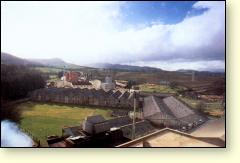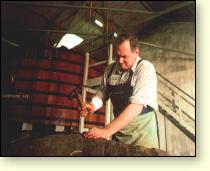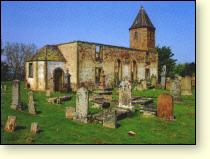
 |
|
Location: Muir of Ord, Ross-shire
Roads: By the A832
Hours: 9.30pm - 4.15pm, Mon - Fri
July - August Sat. 9.30 - 4.15; Sun 12.30 - 4.15
November - February : Restricted hours
Group bookings by appointment
Reception centre, shop and exhibition
Phone: 01463-871334
|
Text from The Whisky Trails, Copyright © Gordon Brown 1993:
The Ord, 15 miles north of Inverness, the Highland capital, is a great flat expanse of land between the shore and the hills. Many a clan battle took place here but most of the time it was the site of market trysts to which droves of cattle, horses and sheep came from all directions.
This is Mackenzie country and clan castles – serene Eilean Donan, Kintail and Brahan – lie mainly to the west. In the 18th century, Brahan, near Ord, was the home of the remarkable Coineach Odhar, widely known as the Scottish Nostradamus. Known as the Brahan Seer, he forecast important future events in minute detail – most of them properly documented – and for his trouble was boiled in oil on a headland near Ord for ‘dabbling in witchcraft’.
The distillery was lit by paraffin lamps until it came on to the national electricity grid after World War II but water power was used for some operations right up to the early 1960s.
In 1598, Thomas Mackenzie bought the Ord area, built Ord House and began farming. Both his alehouse and the House were fed by the Allt Fionnaidh burn with pristine water, and it was the same supply tapped by a kinsman, Alexander Mackenzie, in 1838 when he built his distillery. Things went well enough for successive owners over the years although there were difficult times which saw the business placed under sequestration orders.
There were nine other licensed stills in the area so the competition for business was stiff. All of the local barley crop was used for distillation – the fastest way to turn raw materials into cash. Whisky was the only manufactured product in the area. One proprietor in the 1870s went bankrupt and died. His pragmatic widow saw to it that this would not happen again by marrying a bank agent, from Beauly, whom she put in charge of the business.
Glen Ord whisky was sold far afield, going out to Singapore, South Africa and other British colonies. The distillery became part of DCL after it failed in 1923.
The peat is cut from local moss in spring, taken to the distillery in autumn and dried before use. In the past it could be left for up to four years in order to get the best results. Today, Glen Ord’s drum maltings operation supplies malted barley to many other distilleries in the north and west of Scotland, so much more peat than Glen Ord distillery could use is brought in and stacked in readiness. Entire sheds lie overbrimming with it at Glen Ord. Malting today is a surprisingly noisy business, as the ventilated kiln fires roar like jet engines.
Glen Ord is one of a number of distilleries that have a single glass wall to the stillhouse, enabling the giant copper stills to be seen from outside. The pagoda heads are still in place.

At Glen Ord Distillery, steam-heated coils have replaced coal-fired stills, but the oak casks give the spirit a smoky sweetness
|
The floor maltings were used until 1961 when they were converted to a Saladin Box operation. This was a system that replaced the maltman turning malt by hand with mechanical turners that ran constantly up and down a malting trough. This is no longer in operation but the long, low-sided concrete box is still in position and may be seen during the distillery tour.
Glen Ord was the site of an eight-year experimentation programme to compare coal, oil and steam as means of heating the stills. From 1958 onwards, batches of spirit were produced by each fuel and monitored to see if they varied; as a result, when the distillery’s two previously coal-fired stills were increased to six in 1966, all of them were fitted with steam-heated coils.

A ruined Gaelic chapel overlooks the wellpreserved, quiet township of Cromarty
|
One of the local smuggling stories concerns Excisemen taking a confiscated cask of whisky upstairs to their bedroom in an inn to safeguard the evidence overnight. By drilling up through the ceiling below and the bottom of the cask, the smugglers’ cronies ‘liberated’ the whisky into a succession of jugs and removed the evidence at the same time. The inn in question is said to be the Bogroy Hotel at nearby Beauly; ask at the bar and they’ll show you the hole!
The Whisky
Text from The Whisky Trails, Copyright © Gordon Brown 1993:
A succession of names has been used for the single malt sold in bottle. In the 1880s some Ord whisky was sold in bottle as Glen Oran. Then it was simply Ord, next came the slightly kitsch Glenordie, and now it has recently been relaunched as Glen Ord. It is lightly peated but shows good round flavour with some smoky sweetness at the finish. ‘Perilously drinkable,’ someone once said.
It is 12 years old and 40% vol. Special vintage one-offs and different ages by independent bottlers are rare. It is used in the make-up of Dewar’s blended Scotch.
Source of water
Allt Fionnaidh
Of interest
Text from The Whisky Trails, Copyright © Gordon Brown 1993:
· Cromarty on the Black Isle to the east is the Highlands’ best-preserved 18th century town, ‘the jewel in the crown of Scottish vernacular architecture.’ Both Georgian grandeur and pawky crow-stepped gables intermingle around the town. One of the buildings is the Court House of 1773 which is now a ‘live’ museum. Sit in on a trial with life-size animated figures. Cromarty also has a 19th-century ice-house and its lighthouse was built by Robert Louis Stevenson’s uncle.
· Dolphin Ecosse boat trips take in World War I gun emplacements, shipwrecks and bottlenose dolphins.
· Slightly weird is the Clootie Well at Munlochy, where strips of cloth (clootie) festoon trees that overhang the running water of the spring. To tie a piece of cloth on a branch is to bring good luck, they say, and the well is surprising evidence that so many people take the trouble to do so.
· The Highland Museum of Childhood at Strathpeffer has themed events and a dressing-up box for children.